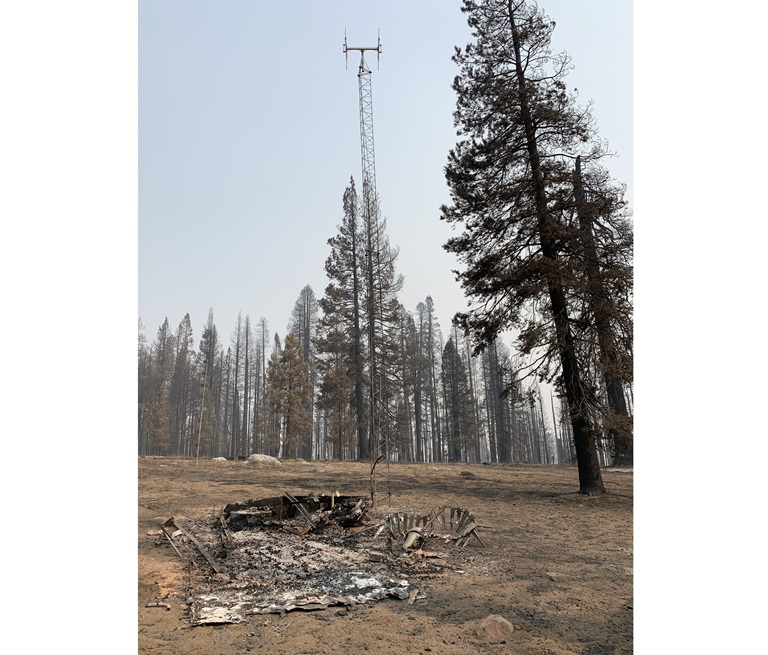Wildfire and Impacts to Water
Although less obvious, wildfire also destroys the monitoring infrastructure that supports water management. Here are the remains of the U.S. Bureau of Reclamation’s Green Mountain snow sensor in the upper San Joaquin River watershed. The 2020 Creek Fire destroyed the sensor and weather station and the tower, although still upright, is unusable. DWR photo.
***This is part 6 in a series of articles DWR is publishing about California’s water year and dry conditions.
The impacts of California’s ongoing dry and warm years were seen this year with a historic wildfire season. Correspondingly, the risk of wildfire damage to water infrastructure is increasing, including risks of secondary impacts from burned area sediment entering waterbodies and affecting water treatment plant operations.
Many of California’s larger reservoirs and associated infrastructure are in forested mountain areas affected by wildfire. The 2013 Rim Fire, for example, damaged various facilities at the San Francisco Public Utilities Commission’s Hetch Hetchy Reservoir, Cherry Reservoir, and Lake Eleanor, including to the Lower Cherry Aqueduct and the Holm Powerhouse and power distribution lines.
The 2018 Carr Fire burned the area surrounding the Bureau of Reclamation’s Keswick Dam and Powerplant, requiring precautionary evacuation of plant operators. The 2020 Bear Fire similarly required evacuation of personnel at the Department of Water Resources’ (DWR) Hyatt Powerplant.
Municipal water systems serving urban areas and rural communities are also at risk. The 2017 Tubbs Fire devastated a highly urbanized area and caused extensive and then-unprecedented damage to the City of Santa Rosa’s water distribution system in the Fountaingrove neighborhood.
The 2018 Camp Fire virtually destroyed the town of Paradise in Butte County, including much of the municipal water distribution system. Also, in 2018 the Klamathon Fire in Siskiyou County left the small community of Hornbrook without water for two months after the main storage tank servicing the community was destroyed.
This year, the Caldor Fire damaged much of the small community of Grizzly Flats in El Dorado County. Parts of the Grizzly Flats water distribution system and storage tanks were destroyed. Temperatures from wildfires can be hot enough to melt buried plastic pipe or water meters. The Caldor Fire also damaged three flumes that make up part of the El Dorado Irrigation District’s conveyance system.
Water agencies may be able to recover some of the costs of repairing wildfire damage and replacing destroyed infrastructure through insurance and state and federal assistance programs. However, extensive water system damage and related water quality contamination can leave residents without water for months.
California’s climate in this century has been drying and warming -- this period includes the statewide droughts of 2007-2009, 2012-2016, and the current conditions that began in 2020. Statistics provided by the California Department of Forestry and Fire Protection (CALFIRE) paint a clear picture of how conditions have been changing and show that all but three of the largest and two of the most destructive wildfires in California have occurred from the year 2000 onward.
Water agencies are experiencing both increased infrastructure damage and increased operational challenges (e.g., emergency response needs, boil water orders.) These impacts are likely to persist, and agencies are encouraged to review their emergency operations plans, participate in mutual aid organizations such as the California Water/Wastewater Agency Response Network, and evaluate needs for increased preparedness.
